Apple Compressor User Manual

Compressor
User Guide
KKApple Inc.
Copyright © 2012 Apple Inc. All rights reserved.
Your rights to the software are governed by the accompanying software license agreement. The owner or authorized user
of a valid copy of Compressor software may reproduce this publication for the purpose of learning to use such software. No part of this publication may be reproduced or transmitted for commercial purposes, such as selling copies of this publication or for providing paid for support services.
The Apple logo is a trademark of Apple Inc., registered in the U.S. and other countries. Use of the “keyboard” Apple logo (Shift-Option-K) for commercial purposes without the prior written consent of Apple may constitute trademark
infringement and unfair competition in violation of federal and state laws.
Every effort has been made to ensure that the information in this manual is accurate. Apple is not responsible for printing or clerical errors.
Note: Because Apple frequently releases new versions and updates to its system software, applications, and Internet sites, images shown in this manual may be slightly different from what you see on your screen.
Apple
1 Infinite Loop
Cupertino, CA 95014 408-996-1010 www.apple.com
Apple, the Apple logo, AppleScript, Apple TV, Bonjour, DVD Studio Pro, Final Cut, Final Cut Pro, Finder, FireWire, iPad, iPhone, iPod, iTunes, Mac, Mac OS, OS X, QuickTime, Shake, Xsan, and Xserve are trademarks of Apple Inc., registered in the U.S. and other countries.
NetInfo is a trademark of Apple Inc.
AppleCare is a service mark of Apple Inc., registered in the U.S. and other countries.
“Dolby,”“Pro Logic,”and the double-D symbol are trademarks of Dolby Laboratories. Confidential Unpublished
Works, © 1992–1997 Dolby Laboratories, Inc. All rights reserved.
IOS is a trademark or registered trademark of Cisco in the U.S. and other countries and is used under license.
UNIX is a registered trademark of The Open Group.
The YouTube logo is a trademark of Google Inc.
Other company and product names mentioned herein are trademarks of their respective companies. Mention of
third-party products is for informational purposes only and constitutes neither an endorsement nor a recommendation. Apple assumes no responsibility with regard to the performance or use of these products.
Production stills from the film“Koffee House Mayhem” provided courtesy of Jean-Paul Bonjour.“Koffee House
Mayhem” © 2004 Jean-Paul Bonjour. All rights reserved. http://www.jeanpaulbonjour.com
Production stills from the film“A Sus Ordenes”provided courtesy of Eric Escobar.“A Sus Ordenes” © 2004 Eric Escobar. All rights reserved. http://www.kontentfilms.com
019-2428
Contents
8 Chapter 1: Compressor basics
8What is Compressor?
9Compressor workflow overview
10Compressor window overview
11Manage Compressor windows
12Compressor terms
14 Chapter 2: Compressor workflows
14Quick and easy batch template workflow
15Manual batch processing workflow
16Custom transcoding workflow
17Chapter 3: Import source media
17Importing overview
18Create a batch
20 Add source media files
20 Add standard source media files to batches
22 Add surround sound source media files to batches
25Add image sequences to batches
26Add metadata to source media files
27Inspector window
29 Batch window
31 Chapter 4: Assign settings and preview media
31Settings overview
32Assign settings
32 Assign settings to source media
34Replace an assigned setting with a different setting
35Modify an assigned setting
35 Create custom settings
35 Create and modify settings
39Share settings
40About the Automatic settings
41Example: Create custom groups and settings for DVD
42Inspector panes
46 Use markers and poster frames
46Markers and poster frames overview
47Manually add and remove markers
49Add compression or podcast markers
51Plain text chapter marker lists
51Set the poster frame
3
52 Preview media
52 Previewing overview
52 Preview media as source or with settings applied
57 Transcode a portion of a clip
59 Preview window
64 Chapter 5: Custom settings and output formats
64Custom settings and output formats overview
65iTunes and Apple device output
65iTunes and Apple device output overview
66Create H.264 settings
70 Create Blu-ray discs
72 Dolby Digital Professional files
72 Dolby Digital overview
74 Convert stereo audio to Dolby Digital Professional format
74 Assign files to surround sound channels
78 Dolby Digital Professional Encoder pane
83Spatial mixing options
84MPEG-2 files
84 MPEG-2 overview
86 Create MPEG-2 files
89 MPEG-2 Encoder pane
97 MPEG-2 bit rates and formats
99About GOPs (groups of pictures)
100AIFF files
100AIFF overview
101Create AIFF settings
102Common Audio Formats files
102Common Audio Formats overview
103Create Common Audio Formats settings
104MP3 files
104 MP3 overview
104MP3 transcoding workflow
105Create MP3 settings
106MPEG-1 files
106MPEG-1 overview
107About system and elementary streams
107MPEG-1 specifications
108Create MPEG-1 files for the web
109Create MPEG-1 video for DVD
110Create MPEG-1 audio for DVD
112 MPEG-1 Encoder pane
114 MPEG-4 files
114MPEG-4 Part 2 overview
115MPEG-4 Part 2 default settings
116Create MPEG-4 Part 2 settings
119 Create settings for an audio podcast
Contents |
4 |
121 QuickTime movie files
121QuickTime movie overview
122QuickTime video codecs
123QuickTime audio codecs
124Create QuickTime media files
130QuickTime Export Components files
130QuickTime Export Components overview
130Create QuickTime Export Components settings
132DV Stream files
132DV overview
133Create DV Stream settings
134Create image sequence files
137 Chapter 6: Assign destinations and submit batches
137Jobs, targets, and batches overview
137Work with destinations
137Destinations overview
138Assign destinations
140 Create and modify destinations
142If a warning triangle appears
143Destinations tab and Inspector
145Set up targets and jobs
145Set up targets
146Add and copy jobs
146Chain jobs
147Submit batches
147Submit a batch
151View batch information in the History window
153 Chapter 7: Advanced functions
153 Add filters
153Filters overview
154Add and adjust filters
156Video filters
163Audio filters
165Color output
166Work with frame controls
166Frame controls overview
167Apply frame controls to a setting
168Frame Controls pane
172About deinterlacing
173About reverse telecine
175About retiming
176Modify geometry settings
176Geometry overview
177Crop, scale, and change frame dimensions
179Geometry pane
Contents |
5 |
184 Add post-transcoding actions
184 Post-transcoding actions overview
184 Add setting actions
186Add job actions
187Job Action tab
198Use Droplets
198Create Droplets
201Use Droplets for transcoding media
204Droplet window
205Use Final Cut Pro X and Motion 5 with Compressor
207Use the command line to submit Compressor jobs
207Shell commands overview
207 Synopsis
207Command options
208Example: Compressor commands
211Compressor preferences
211Set Compressor preferences
212Preferences window
214 Chapter 8: Use Apple Qmaster to set up a distributed processing system
214What is Apple Qmaster?
215Distributed processing systems
215Distributed processing overview
217Distributed processing basics
218Distributed processing setup guidelines
219Examples of distributed processing systems
220Additional components of a distributed processing network
221How the Apple Qmaster system distributes batches
222Create service nodes and cluster controllers
222Creating service nodes and cluster controllers overview
223Quickly set up a service node using This Computer Plus
224Set up a cluster controller using QuickClusters
225Advanced service node and cluster controller information
225Use nodes without Compressor installed
228Enable managed and unmanaged services
229Schedule service availability
230Use virtual clusters to make the most of multicore computers
231Turn cluster controller services on or off
231Set a service password for including a computer in a cluster
232Use cluster storage
234Rendering services and shared storage setup
234Use distributed processing with Shake
235Recovery and failure notifications
236Process a batch
236Batch processing overview
237Submit a batch of files from Compressor
238Submit a batch of Shake files using Apple Qmaster
240Submit a batch of Maya files using Apple Qmaster
242Submit a batch of files using the Generic Render command in Apple Qmaster
Contents |
6 |
244 Advanced rendering information
244Set environment variables in Apple Qmaster
245Manage Shake media files on a shared volume
245Shake plug-in dialog
246Generic Render dialog
247Use Mental Ray for Maya
247 Use Apple Qmaster to submit UNIX commands
249 Job segmenting and two-pass or multi-pass encoding
249Example:Submit After Effects batches with the Generic Render command
250Apple Qmaster window
250 Apple Qmaster window
253 Apple Qmaster Sharing window
253Setup pane of the Apple Qmaster Sharing window
254Advanced pane of the Apple Qmaster Sharing window
256Set Apple Qmaster preferences
257 Chapter 9: Use Apple Qadministrator to create and modify clusters
257What is Apple Qadministrator?
257Open Apple Qadministrator
258Create and modify a cluster
262Monitor cluster activity
262Set Apple Qadministrator preferences
265 Chapter 10: Keyboard shortcuts
265 Compressor keyboard shortcuts
Contents |
7 |
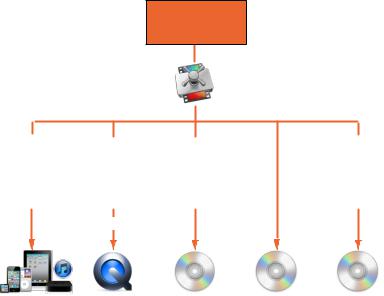
Compressor basics |
1 |
|
What is Compressor?
Compressor is an application for converting audio and video files into professional media formats for disc, device, or web delivery.The process of converting from one file format to another is called transcoding. You can use Compressor on its own or with Final Cut Pro X and Motion to transcode audio and video files directly from those applications.
In Compressor, you can:
•• Convert source media to high-definition (HD) or standard-definition (SD) formats (including H.264) for Apple devices such as Apple TV, iPhone, iPad, iPod, or iTunes; for streaming or podcasting on the web; for DVD, CD-ROM, or Blu-ray Disc; or for handoff to post-production.
Source media or
Final Cut Pro project
|
|
MP3 |
|
AC-3 |
|
|
|
|
H.264 |
|
|
AIFF |
|
AIFF |
|
H.264 |
|
|
MPEG-1 |
|
|
|
||||
MP3 |
|
|
H.264 |
|
MP3 |
|
||
|
MPEG-4 |
|
|
|
AC-3 |
|||
AC-3 |
|
|
MPEG-1 |
|
QuickTime |
|
||
|
QuickTime |
|
|
|
|
|||
|
|
|
MPEG-2 |
|
|
|
|
|
|
|
|
|
|
|
|
|
|
|
|
|
|
|
|
|
|
|
To web
Apple TV |
QuickTime |
DVD video |
CD-ROM |
Blu-ray Disc |
iPhone |
movie |
|
|
|
iPad |
(for broadband |
|
|
|
iPod |
and lowband) |
|
|
|
iTunes |
|
|
|
|
••
••
••
••
Use batch processing to create multiple output files from single-source media files.
Create standalone applications called Droplets for drag-and-drop transcoding operations on your desktop. Simply drag a media file onto a Droplet to launch a customized transcoding session, without opening Compressor.
Use Apple-supplied encoding settings or create your own settings to build a library of specialized settings that can be reused.
Apply video filters to add fade-in/fade-out effects, timecode overlays, gamma correction, noise removal, letterbox framing, watermarks, color adjustments, and more.
8
••
••
••
••
••
••
••
••
••
••
••
••
Apply audio filters to control dynamic range, peak levels, equalization, and audio fade-in/ fade-out effects.
Use the Preview window to view the results of your filter settings in real time.
Create and save output destinations, including your desktop, local disks, remote disks, and FTP locations.You can even use destination presets to specify filenaming conventions.
Control video file image quality during MPEG-2 DVD transcoding by applying singleor dualpass variable bit rate (VBR) to your output files.
Customize your frame dimensions using geometry controls. You can resize your image to common aspect ratios, including 4:3, 16:9, and 2.35:1, or reduce file size by cropping unwanted image areas.
Publish your media files to a QuickTime Streaming Server or other locations for DVD authoring. Customize post-transcoding operations by applying AppleScript automation to your output files.
Export sequences directly from Final Cut Pro X or Motion into Compressor for transcoding, leveraging the powerful video-processing technology of those applications.
Encode media files in the background so that you can perform other tasks at the same time.
Automatically send an email notification to any location to notify you or your colleagues when a transcoding job is complete.
Use distributed processing to divide the transcoding work among multiple computers, thereby increasing your processing power. The distributed processing feature is limited to computers that have Compressor installed.
Enable and disable distributed processing services and monitor batches using command-line options.
Compressor workflow overview
Compressor offers several ways to convert (transcode) media files into any of numerous professional file formats. For basic transcoding jobs to common output formats (Blu-ray Disc, DVD, Apple TV,YouTube, and so on), choose a preconfigured template to have Compressor automatically apply all required settings. For more advanced transcoding jobs, apply an output setting from a list of more than 30 file formats.
Whether basic or advanced, all transcoding workflows in Compressor follow the same essential steps:
••
••
••
••
Import your source media into Compressor. Apply and modify your preferred output settings.
Specify a save destination (the location where the output files are saved). Submit your file or batch of files for transcoding.
Chapter 1 Compressor basics |
9 |
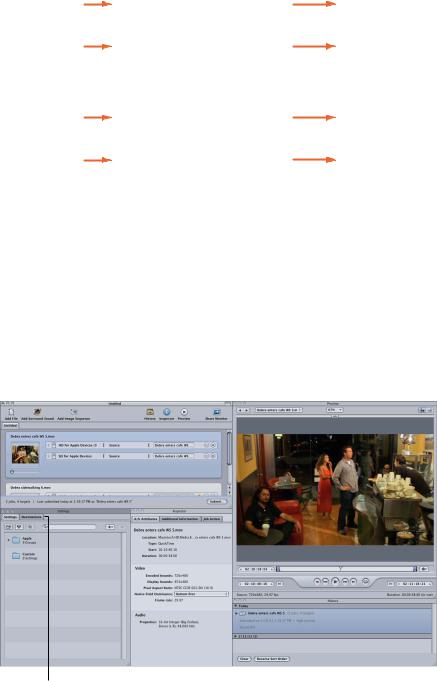
Each transcoding session in Compressor is known as a batch. A transcoding batch can contain multiple source media files, referred to as jobs. Each job can be transcoded into multiple formats. The following diagram represents a batch containing two jobs:
|
|
|
|
Batch |
|
|
|
|
|
|
|
|
Job 1 |
|
|
|
|
|
|
|
|
|
|
|
|
|
|
|
Target 1 |
|
|
Output media file |
|||
|
Source |
|
|
Setting |
|
|
Destination |
|
|
|
(Job 1, Target 1) |
|
|
|
|
|
|
|
|
||||
|
media file |
|
|
|
|
|
|
|
|
|
|
|
|
|
|
|
|
|
|
|
|
|
|
|
1 |
|
|
|
Target 2 |
|
|
Output media file |
|||
|
|
|
|
Setting |
|
|
Destination |
|
|
|
(Job 1, Target 2) |
|
|
|
|
|
|
|
|
|
|
|
|
|
Job 2 |
|
|
|
|
|
|
|
|
|
|
|
|
|
|
|
Target 1 |
|
|
Output media file |
|||
|
Source |
|
|
Setting |
|
|
Destination |
|
|
|
(Job 2, Target 1) |
|
media file |
|
|
|
|
|
|
|
|
|
|
|
|
|
|
|
|
|
|
|
|
|
|
|
2 |
|
|
|
Target 2 |
|
|
Output media file |
|||
|
|
|
|
Setting |
|
|
Destination |
|
|
|
(Job 2, Target 2) |
|
|
|
|
|
|
|
|
|
|
|
|
|
|
|
|
|
|
|
|
|
|
|
|
In the diagram above, each job is converted to two output files.The settings and save destinations of these files are known as the targets. One output media file is created for each target assigned to a source media file.The total number of output files created by transcoding this batch will be four:Job 1 will create two output media files, as will Job 2.
Compressor window overview
The main Compressor workspace has five windows, each of which represents a part of the transcoding workflow:
|
|
|
Batch window |
|
|
Preview window |
||
|
|
|
|
|||||
|
|
|
|
|
|
|
Settings and |
|
Inspector |
|
History |
||
|
|
|||||
Destinations tabs |
|
window |
|
window |
||
Chapter 1 Compressor basics |
10 |
••
••
••
••
••
Batch window: Import source media files and add transcoding settings and save destinations in this window.
Settings and Destinations window: Choose settings and output destinations from the two tabs in this window. The Settings tab contains more than 30 Apple-provided settings for common media formats (for Apple devices, Blu-ray and DVD discs, web streaming, video-sharing services such as YouTube, and so on). You can add your own custom settings to this list. The Destinations tab contains common save locations (Desktop, User’s Movies Folder, and so on). You can add your own custom save destinations to this list.
Inspector window: Adjust common transcoding controls and view a summary table listing the details of each setting. You can also use the Inspector window to gather information about source clips.
Preview window: Preview the results of your transcoding settings in this window. A split-screen feature lets you compare the original media to the modified version, before you output. Here you can see the effects of applied filters and frame resizing, and you can make adjustments to these attributes while previewing the results in real time. You can also use the Preview window to add and view various kinds of markers.
History window: See a complete log of all batches submitted from your computer, including progress bars of batches still being transcoded. You can pause or resubmit any batches listed in the log.
You can display the Compressor workspace in either of two basic default layouts. The standard layout displays all the Compressor windows, with the Settings and Destinations tabs sharing a window; this layout is optimized for those times when you’re transcoding a single-source media file.The batch layout places the emphasis on the Batch window and is optimized for those times when you’re transcoding multiple source media files. As you work, you can switch between these layouts. You can also create a custom layout and save it for future use.
Manage Compressor windows
The five windows of the Compressor workspace can be moved and resized independently of one another, allowing you to customize your work environment.
View a specific window
mm Choose Window > window name.
Bring all Compressor windows to the front
Do one of the following:
mm Choose Window > Bring All to Front.
mm Click the Compressor application icon in the Dock.
Choose a layout
mm Choose Window > Layouts, and choose a layout from the list that appears.
The Compressor interface changes to match the new layout.
Save a layout
1Arrange the Compressor windows.
2Choose Window > Save Layout.
3In the dialog that appears, enter a name for the layout and click Save.
The layout is saved and appears in the layouts list when you choose Window > Layouts.
Chapter 1 Compressor basics |
11 |
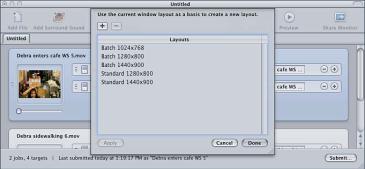
Manage layouts
1Choose Window > Manage Layouts.
A dialog for managing layouts appears.
2 Do any of the following:
•• To rename a layout: Double-click it and type the new name.
•• To remove a layout: Select it and click the Delete (–) button.
•• To save the current interface configuration as a new layout:Click the Add (+) button and enter a name for the layout.
•• To choose a layout and apply it to the current Compressor interface: Choose the layout and click the Apply button.
3When you’ve finished managing your layouts, click Done.
The dialog closes and the Compressor interface changes to match the chosen layout setting.
Note: The layouts list is actually divided into two sections—the ones supplied by Apple and the ones that you create. You cannot rename or delete the Apple-supplied layouts. The ones that you create are listed in alphabetical order. Use care when naming your layouts so that you can easily locate them in the list.
Compressor terms
This section covers common terms that you’ll encounter as you use Compressor.
••
••
••
••
••
Codec: Short for COmpression/DECompression. A mathematical model for reducing the data of a source media file.
File format: The output format used to transcode your source media file.
Transcoding: The process of converting files from their original format to output files ready for distribution in another format. Closely related terms include compression, which specifically refers to data reduction, and encoding, a term that is essentially synonymous with transcoding, but doesn’t emphasize the conversion aspect.
Source media file:The original media file to be converted to a new file format.
QuickTime: The cross-platform multimedia technology that allows OS X and Windows applications to capture and play back video, audio, and still-image files. QuickTime files can contain many different kinds of media and codecs. Codecs give instructions to QuickTime on how to play back the media.
Chapter 1 Compressor basics |
12 |
•• Setting: A group of attributes applied to a source media file during the transcoding process.
Each setting contains the following attributes (which you can modify in the Inspector window):
•• Output (file) format:The encoder you choose to convert your source media file. Choose one of the following output formats based on the intended playback method: AIFF, Dolby Digital
Professional, DV Stream, H.264 for Apple Devices (which contains settings for use with iPhone, iPad, iPod, and Apple TV), Image Sequence (which supports TIFF and TARGA images), MPEG-1, MPEG-2, MPEG-4, QuickTime Movie, or QuickTime Export Components.
•• Filters: Special effects that adjust different characteristics of your video (such as color, brightness, and sharpness) to maximize your video quality as the file is converted.
•• Geometry: Controls to crop the image and adjust its frame size.
•• Actions: Controls to create actions that are automatically applied to output files after transcoding. Use this feature to send email notifications and execute tasks using Automator.
•• Destination: The location where your transcoded media file is saved.You can either use the default destination (the same folder the source media file is in) or choose a custom destination that you created.The destination also controls how the transcoded media file is named.
•• Target: The area of the Compressor workspace (in the Batch window) where you designate the setting, destination, and output filename.Think of it as the blueprint for creating an output media file.
•• Job: The source media file and the target (setting and destination) you apply to it, ready to be transcoded.
•• Batch: One or more jobs that are processed at one time. All jobs contained within the batch are submitted collectively when you begin the transcoding process.
•• Output media files:The transcoded media file (or files) created after the batch is submitted and processed.You can create as many output media files as there are different settings applied to the various source media files in the batch.
Chapter 1 Compressor basics |
13 |
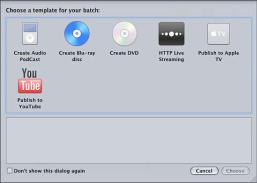
Compressor workflows |
2 |
|
Quick and easy batch template workflow
If you want to transcode your source media files immediately and don’t need to create your own settings, you can use the batch template settings that are preconfigured in Compressor.The following workflow shows you a quick and easy way to use Compressor with batch templates.
Stage 1: Choose a template
In the Batch Template Chooser, you’ll select a template to transcode your media. For more information, see Batch window on page 29.
Note: The default set of templates is shown below. If you’ve created other templates, they will also appear in the Batch Template Chooser.
Stage 2:Import source media files
Although there are many ways to import source media into Compressor, the easiest method is to drag a source file from the Finder or the desktop to the placeholder job in the Batch window. For more information, see Importing overview on page 17.
Stage 3: Submit your batch for processing
After you’ve chosen a template and provided a file to transcode, you can submit the batch that contains your job. By default, the batch templates use Source (the same folder that the source media files originated from) as the destination for the encoded files. For information about choosing other destinations, see Destinations overview on page 137.
You can view the progress of your transcode in the History window in Compressor. It contains a progress bar and tells you if a submission was successfully transcoded.
14
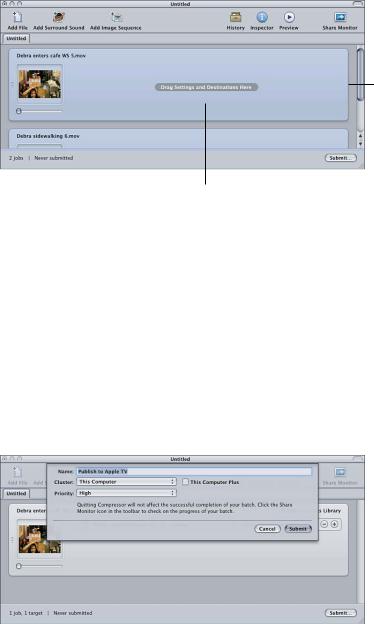
Manual batch processing workflow
If none of the preconfigured batch settings work for your transcode but you want to use the settings and destinations that come with Compressor, you can manually build and process your batch. The following workflow shows you an easy way to manually build and process a batch in Compressor, summarizing each stage in the process and providing links to the instructions you’ll need.
Stage 1:Manually import source media files
You’ll need to manually import each source media file into Compressor, either by dragging files into the batch or by clicking the Add File button. After you import files, you’ll see that new jobs are created for each source file you added to the batch.
Each source file creates a job in the batch.
Target area (empty in this case) of a job
For more information, see Importing overview on page 17.
Stage 2: Assign settings and destinations
You’ll need to assign at least one setting and destination to each source media file job before you can submit the batch for processing. You can also add multiple settings to the same job to transcode multiple versions of the media file. Each setting-destination pair is known in
Compressor as a target.
For instructions on how to assign settings and destinations, see Assign settings to source media on page 32 and Destinations overview on page 137.
Stage 3: Submit your batch for processing
When each media file has at least one setting and destination associated with it, you can submit your batch for processing. For more information, see Submit a batch on page 147.
You can view the progress of your transcode in Share Monitor. This is a good way to monitor when your batch has finished transcoding and if any problems occurred during the transcoding process. For more information about Share Monitor, see Share Monitor Help.
Chapter 2 Compressor workflows |
15 |
Alternatively, you can view the progress of your transcode in the History window in
Compressor. It contains a progress bar and, like Share Monitor, it can tell you if a submission was successfully transcoded.
Custom transcoding workflow
You can create your own settings and destinations, and customize other attributes such as filters, cropping, frame resizing, and actions settings to create your own custom transcoding process.The workflow below summarizes each stage in the process and provides links to the instructions you’ll need.
Stage 1:Import source media files
You can import source media files into a batch, either by dragging the files from the Finder to the Compressor Batch window or by clicking the Add File button.You can import source media files from any folder that you have access to. For more information, see Importing overview on page 17.
Stage 2: Create and assign one or more settings
Compressor has many output formats you can use to create a setting. For more information about the various output formats available in Compressor, see Custom settings and output formats overview on page 64. For instructions for creating your own customized settings, see Settings overview on page 31.
You can also add filters, geometry settings, and post-transcoding actions to your settings. For more information, see Filters overview on page 153, About deinterlacing on page 172, Geometry overview on page 176, and Post-transcoding actions overview on page 184.
You can streamline your workflow by putting your settings into groups. For more information, see Create and modify settings on page 35.
After creating a setting, you can preview it to check your work. For more information, see Previewing overview on page 52.
Note: Frame Controls settings cannot be previewed in the Preview window. To preview Frame
Controls settings, you can do a test transcode using a small section of your source media file. For more information, see Transcode a portion of a clip on page 57.
Stage 3: Create one or more destinations
By default, your transcoded file is saved in the same folder that the source media file originated from. If you want to store your transcoded files in a different location, you can create a new destination. For more information, see Destinations overview on page 137.
Stage 4: Submit your batch for transcoding
After you’ve created and previewed all the jobs you want in the batch, you submit the batch. For more information, see Jobs, targets, and batches overview on page 137.
You can view the progress of your transcode in Share Monitor. This is a good way to monitor when your batch has finished transcoding and if any problems occurred during the transcoding process. For more information about Share Monitor, see Share Monitor Help.
Alternatively, you can view the progress of your transcode in the History window in
Compressor. It contains a progress bar and, like Share Monitor, it can tell you if a submission was successfully transcoded.
Chapter 2 Compressor workflows |
16 |
Import source media |
3 |
|
Importing overview
The first step in the traditional Compressor transcoding process is to import at least one source media file into the Batch window, thus creating a batch.
If you’re using the batch template workflow, the first step is to choose a batch template. For more information, see Quick and easy batch template workflow on page 14.
Here are some tips for importing source media:
•• About highly compressed source files:It’s strongly recommended that you do not use highly compressed files, such as MPEG files, as your source files, because they can cause artifacts in the encoded video.
•• When importing QuickTime reference movies: If you submit a reference movie for distributed processing, the Apple Qmaster distributed processing system automatically copies the appropriate media files to the processing cluster. For the best performance, you can avoid this file transfer step by making sure that the media files specified in the reference movie are available to each node of the Apple Qmaster cluster. For more information, see How the Apple Qmaster system distributes batches on page 221.
•• When importing MPEG-2 files:When you import an MPEG-2 file, Compressor must parse the file before you can play it in the Preview window. Parsing the file involves determining its frame structure and other necessary information about the file. Because the frame structure can change throughout the file, Compressor must scan the entire file, which can take several minutes for longer files.
This doesn’t happen with MPEG-2 elementary files encoded using Compressor that had the
“Add DVD Studio Pro metadata” checkbox selected. For more information, see MPEG-2 Encoder pane on page 89.
•• When importing Dolby Digital Professional source media: You can use Dolby Digital Professional
AC-3 audio files as source media files for your jobs.There are two common reasons to do this:
•• To test a file you just encoded:Because you cannot preview the Dolby Digital Professional output settings, importing an encoded file into a job allows you to play it and verify the settings.
•• To convert a Dolby Digital audio file to another format:Because not all media players include
Dolby Digital decoders, you may find that you need to transcode the file to another format.
17
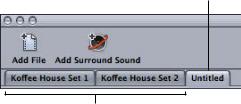
Compressor includes a Dolby Digital decoder that it uses to play or transcode Dolby Digital audio files.This means you can verify the Dolby Digital Professional output settings of a previously encoded file on your system without using an external Dolby Digital decoder.To hear surround sound you must have an external surround sound device connected to your computer’s USB or FireWire output. The audio is mixed down to two channels if you play the audio using your system’s stereo speakers.
Important: Because the audio output is already decoded and not in the Dolby Digital format, the optical output cannot be used when playing Dolby Digital files from Compressor.
Tip: If Compressor doesn’t allow you to add a Dolby Digital file to a job, add the extension .ac3 to the filename.
•• About automatic values and nonstandard QuickTime: Compressor uses a variety of tactics to determine the proper values for any settings that are set to Automatic. In most cases,
QuickTime files contain metadata specifying the various attributes of the file, such as frame rate and frame size. In some cases, this metadata is not present, forcing Compressor to try to determine this information, or it’s incorrect, causing Compressor to generate incorrect values for the Automatic settings. Additionally, some QuickTime files use nonstandard settings that require Compressor to choose an automatic value that may not be suitable. For these reasons, it’s a good idea to verify that the Inspector values are set to Automatic. For more information, see About the Automatic settings on page 40.
Create a batch
Batches—groups of one or more jobs—are the heart of your Compressor workflow, and the
Batch window is where you work with the batches. The Batch window provides a central location for organizing your transcoding tasks and quickly assigning settings.
When you first open Compressor, the Batch window appears, and as you open more baches, each appears as a tab at the top of the window. Batches can be saved, closed, and opened again. For more information, see Batch window on page 29.
Create a batch using default settings mm Choose File > New Batch.
A new, untitled batch is added to the Batch window.
The new batch’s tab
Each tab is for
a different batch.
The Batch window has a Submit button, located in the lower-right corner, that you can use to begin transcoding the currently selected batch. The lower-left corner shows the status of the current batch (how many jobs it contains and whether it has been submitted).
Chapter 3 Import source media |
18 |
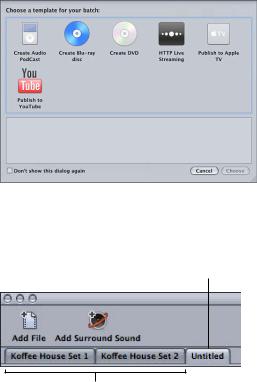
Create a new batch using a batch template
1Choose File > New Batch from Template.
The Batch Template Chooser appears, containing preconfigured templates and any templates you’ve created.
For information about the templates in the Batch Template Chooser, see Batch window on page 29.
2Select a batch template and click Choose.
A new, untitled batch is added to the Batch window.
The new batch’s tab
Each tab is for
a different batch.
The Batch window has a Submit button, located in the lower-right corner, that you can use to begin transcoding the currently selected batch. The lower-left corner shows the status of the current batch (how many jobs it contains and whether it has been submitted).
Create a custom batch template
You can save any batch as a custom batch template. Custom batch templates appear as options in the Batch Template Chooser, alongside the default Apple batch templates. Custom batch templates can save you time, particularly with workflows that you repeat often.
1In the Batch window, create a new batch.
Tip: Alternatively, open a saved batch with the characteristics that you want in the batch template.
2Adjust the batch settings as appropriate. For more information, see Assign settings to source media on page 32 and Destinations overview on page 137.
3Choose File > Save as Template.
4In the dialog that appears, enter a name and description, and click OK.
The custom batch template is saved and appears in the Batch Template Chooser.
Chapter 3 Import source media |
19 |
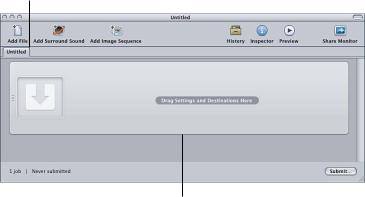
Add source media files
Add standard source media files to batches
Before you add any transcoding settings to a batch, you need to import the source media files into the batch. Importing the source media files into the batch automatically creates a job.
Following are the details for adding standard (not surround sound or image sequence) source media files to a batch.
Add source media files to a batch
1Open Compressor.
The Batch window opens with an empty batch tab named Untitled.
Untitled batch tab
Empty batch area with a placeholder job
Note: If the Batch Template Chooser opens automatically, click Cancel to close it. To prevent the Batch Template Chooser from opening when you open Compressor, select the “Don’t show this dialog again” checkbox, or, in Set Compressor preferences, select For New Batches: Use Blank Template.
2Do one of the following:
•• Choose Job > New Job With File (or press Command-I), navigate to the folder that contains your source media, select one or more source media files, and click Open.
••
••
Click the Add File button (in the Batch window toolbar, if visible), navigate to the folder that contains your source media, select one or more source media files, and click Open.
Control-click a job and choose Source > File from the shortcut menu.
Chapter 3 Import source media |
20 |
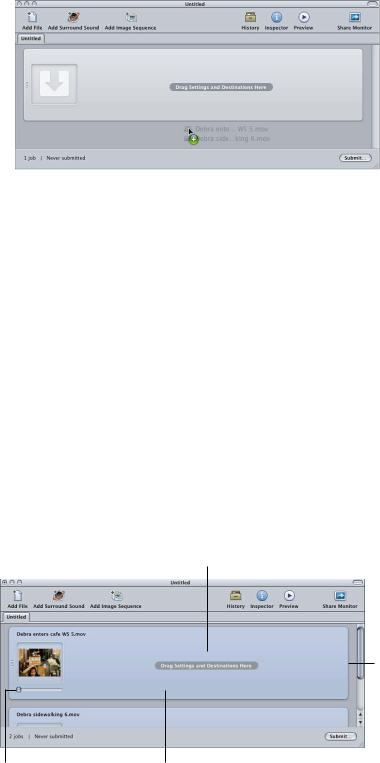
••
••
Control-click an empty area of the batch and choose New Job With File from the shortcut menu. You can then navigate to the folder that contains your source media, select one or more source media files, and click Open.
Open your source media file folder and drag one or more source media files into the batch.
Note: You can combine the above steps by selecting all the source media files you want to transcode before opening Compressor and then dragging them to the Compressor application icon.
This opens Compressor and adds the media files to the default untitled batch at the same time.
3To save the batch, choose File > Save As (or press Command-Shift-S).
4In the dialog that appears, enter a name for the batch and choose the location where you want to save it.
5Click Save.
The tab in the Batch window changes to match the name of the file.
Note: If your Finder preferences are set to show file extensions, the extension .compressor appears in the tab along with the name.
You’re not required to name and save your batches, and for quick jobs you might decide not to.
However, naming and saving a batch makes it easy to go back and resubmit it later if you find that the output files were not as expected or if your needs change. It also makes it easier to figure out what’s in the History window and in Share Monitor if you submit multiple batches in a short period of time.
The batch now contains your selected media files, each in its own job. Source media files with video content also include a thumbnail image and a scroller that you can use to scroll through the video.
The targets for this job will appear in this area.
Each source media file creates a job.
Drag the slider to scroll through video files.
Click anywhere in the job to see this file’s attributes in the Inspector window.
Chapter 3 Import source media |
21 |
Change the source media file assigned to a job
1In the Batch window, select the job whose source media file you want to change.
2Do one of the following:
•• Choose Job > Source > File, navigate to the folder that contains your source media, select one or more source media files, and click Open.
••
••
Control-click the job and choose Source > File from the shortcut menu. You can then navigate to your source media, select one or more source media files, and click Open.
Drag a new source media file to the job.
Any targets you had already configured remain and are now applied to the new source media file.
Remove a source media file from a job
mm Control-click the job and choose Clear Source from the shortcut menu.
Remove jobs from a batch
Do one of the following:
mm To remove a single job: Select the job and press Delete.
mm To remove all jobs: Control-click in an empty part of the batch and choose Remove All Jobs from the shortcut menu.
You can now add targets to your jobs.
Add surround sound source media files to batches
There are two methods you can use to add audio files to a batch to create a surround sound job: an automatic method that relies on filenaming to map the audio files to the proper channels and a manual method that allows you to manually assign the audio files to the channels.
Each method results in a job to which you can add a setting that supports surround sound audio outputs, such as Dolby Digital Professional, AIFF, and several audio codecs in the QuickTime Movie output format.
Important: Some of the output formats have multiple configurations for the surround sound audio channels. Be sure you know which configuration your intended playback device requires. For example, the AIFF output format provides four different configurations for 5.1 (six-channel) audio outputs, with the difference being the order of the channels.
Assign files to surround channels with channel identifier codes
1In the Finder, append the channel identifier code of the target surround channel to the filename of each source audio file using these codes:
•• -L: Left front channel
•• -R: Right front channel
•• -C: Center front channel
•• -Ls: Left surround channel
•• -Rs: Right surround channel
•• -S: Center surround channel
•• -LFE: Low-frequency effects channel (Subwoofer, LFE)
Chapter 3 Import source media |
22 |
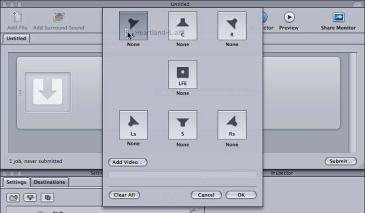
For example, to assign an AIFF file to the left surround channel, rename the filefilename-Ls.aiff(where filename is the name of your file).The channel identifier codes must include the hyphen, as shown.
Note: OS X may add a file extension like .aiff.This will not interfere with this channel assignment method.
This procedure works only when you drag files into the Batch window. If you drag the files onto the Compressor application icon, they’ll appear as separate source files, each in its own job.
Note: If you’re creating Dolby Digital Professional (AC-3) surround sound streams, you won’t use all the channels listed in the table at once. For a diagram of the Dolby audio coding modes, see Dolby Digital Professional Encoder pane on page 78.
2Drag the renamed source audio files to the Batch window.
If the files in the group are named correctly (see step 1) and the group has fewer than seven files, Compressor collapses the entire group of files into what appears as a single surround source media file in the Batch window
Manually assign source audio files to channels of a surround sound stream
1To import the source audio files, do one of the following:
•• Choose Job > New Job With Surround Sound Group (or press Command-Control-I).
•• Click the Add Surround Sound button in the Batch window.
•• Control-click in the batch and choose New Job With Surround Sound Group from the shortcut menu.
The channel assignment interface opens.
2To assign a source audio file to a channel, do one of the following:
•• Drag the source audio file from the Finder to the icon for a specific channel (for example, L).
•• Click the icon for a specific channel (for example, L) and use the Open dialog to locate the source audio file intended for that channel.
The file is now assigned to the L (left front) channel.
3Repeat step 2 for each of the source audio files that you intend to include in the surround stream.
Note: If you’re creating Dolby Digital Professional (AC-3) surround sound streams, you won’t use all the channels listed in the table at once. For a diagram of the Dolby audio coding modes, see Dolby Digital Professional Encoder pane on page 78.
Chapter 3 Import source media |
23 |
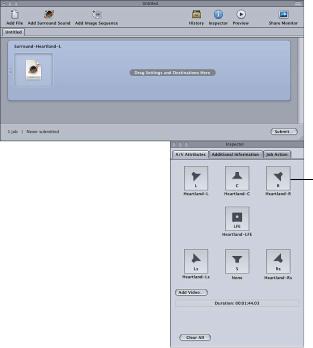
4To include a video file, click the Add Video button and select a video file.
5When you’ve finished adding source audio and video files to the channel assignment interface, click OK.
The group of surround files appears as a single surround source media file job in the Batch window.
Change a surround sound file assignment
After you create a surround sound job, the Batch window shows the surround sound icon in the source media file thumbnail (unless a video file was added to the job), and the Inspector window shows the channels and their assigned files.
Click a channel’s icon to change the file assigned to that channel.
You can change any of the file assignments in the Inspector window.
1Click the speaker icon of the channel you want to change.
2In the dialog that appears, locate the file to assign to that channel and click Open.
3To add a video file, click Add Video and select a video file.
You can replace a video file that is already assigned by deleting it and clicking Add Video to choose a different video file.
For information about creating Dolby Digital Professional output files, see Dolby Digital overview on page 72.
Chapter 3 Import source media |
24 |
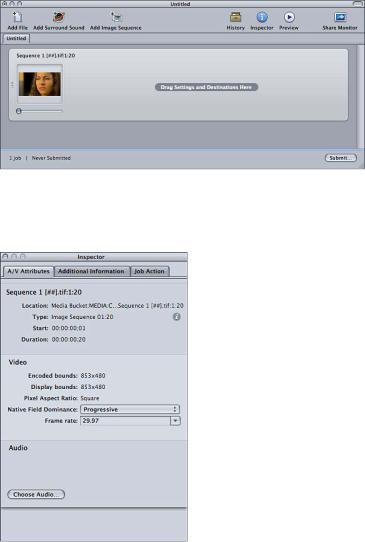
Add image sequences to batches
You can import a sequence of still images into Compressor as a single image sequence job and then apply an output frame rate and an audio file to the job. From that point, you treat the job as you do any other Compressor source media file, adding settings, destinations, filters, and post-transcoding actions to create an output media file with the video and audio formats and characteristics you want.
Add a still image sequence job to a batch
1Do one of the following:
•• Click the Add Image Sequence button and navigate to the folder containing the image sequence files you want to import.
•• Choose Job > New Job With Image Sequence (or press Command-Option-I) and navigate to the folder containing the image sequence files you want to import.
2Click Open.
The new job appears in the Batch window.
3Select the job in the Batch window.
The Inspector window displays the A/V Attributes tab containing information and controls for the new image sequence job.
Chapter 3 Import source media |
25 |
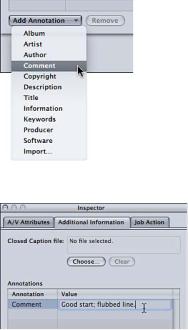
4 Do any of the following:
••
••
••
••
••
Confirm the selected image sequence files.
To view the complete list of files, click the Info (i) button. Confirm the video format information in the Video section.
Adjust the field dominance for the source files by choosing an option from the Native Field
Dominance pop-up menu.
Adjust the frame rate for the source files by choosing a standard frame rate from the Frame
Rate pop-up menu.
If you want to add an audio file to the image sequence job, click Choose Audio and select an audio file.
Note: Compressor supports the following audio file types for image sequences:AIFF, MP3,
MPEG-4 audio-only (.m4a), and QuickTime movie (.mov).
You can also use Compressor to output an image sequence. For more information, see Create image sequence files on page 134.
Add metadata to source media files
You can annotate a source media file with information that is important for your workflow. Additionally, some types of source media need to be identified before a job can be processed.
Note: The Add Annotation feature is supported by the H.264 for Apple Devices, MP3, and
QuickTime Movie output formats.
Add an annotation to a source media file
1Click the job to show the source media file’s attributes in the Inspector window.
2Click the Additional Information tab.
3Choose the type of annotation from the Add Annotation pop-up menu.
4 Double-click the corresponding Value field and enter the annotation text.
5 To save the annotation, press Return or click in the next field.
Chapter 3 Import source media |
26 |
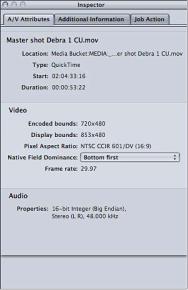
Associate a closed caption file with a job’s source media file
1Click the job to show the source media file’s attributes in the Inspector window.
2Click the Additional Information tab.
3Click Choose, locate the closed caption file (must be a Scenarist closed caption format file, usually with the file extension .scc), and click Open.
Note: Closed caption data is supported by the H.264 for Apple Devices, MPEG-2, and QuickTime
Movie output formats.
Depending on the output format of the job’s target, Compressor applies the closed caption file to the output media files.
••
••
••
For QuickTime outputs: Compressor adds the closed caption file as a closed caption track to the QuickTime output file.You can view the closed captions using QuickTime Player (version
7.2 or later).
For MPEG-2 elementary stream outputs: Compressor embeds the closed caption data in an elementary MPEG-2 video stream so that it can be used for DVD authoring.
For MPEG-2 program and transport stream outputs: Compressor embeds the closed caption data in program and transport MPEG-2 streams using the EIA-708 ATSC protocol.
Important: The timecode values in the closed caption file must directly relate to the timecode of the source media file.You can open a closed caption file in TextEdit to see the timecode values it contains (the actual text is encoded and cannot be read this way).
Inspector window
When you select a batch’s job, the Inspector window shows you information about the job’s source media file.
The Inspector window contains three tabs: A/V Attributes, Additional Information, and Job Action.
A/V Attributes tab
The A/V Attributes tab contains general information about the source media file and is divided into three sections.
Chapter 3 Import source media |
27 |
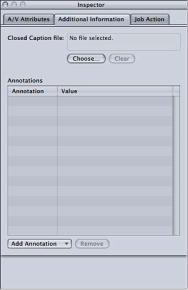
••
••
••
File information: This section shows the filename, location, and type of file.
Video information: This section, when applicable, shows all video-related information about the file.This includes its frame size, frame rate, and timecode information.
Audio information: This section, when applicable, shows all audio-related information about the file.This includes its sample size and sample rate.
Additional Information tab
The Additional Information tab allows you to see and modify a variety of metadata items that might have been added in other applications such as Final Cut Pro or QuickTime. You can also add metadata to the output media file, or associate a closed caption file with the output file.
••
••
••
••
••
••
Closed Caption file field:Displays the name of the closed caption file currently associated with the source media file.
Choose (closed caption) button:Use this button to open a dialog and navigate to the closed caption file you want to associate with the source media file.
Clear button: Use this button to remove the associated closed caption file.
Annotations table: Displays the current annotation types and the corresponding annotation text.
Add Annotation pop up menu: Choose the type of annotation you want to add to the source media file.
Remove (annotation) button:Use this button to remove the selected annotation.
Job Action tab
The Job Action tab allows you to apply and adjust post-transcoding actions for entire jobs. For information about using the Job Action tab, see Post-transcoding actions overview on page 184.
Chapter 3 Import source media |
28 |
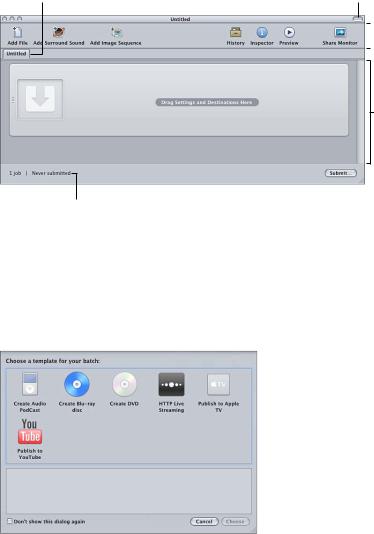
Batch window
The Batch window provides a central location for organizing your transcoding tasks and quickly assigning settings.When you first open Compressor, the Batch window appears with an empty, untitled batch. Think of batches as documents that can be saved, closed, and opened again. You use the toolbar at the top of the Batch window to open all other Compressor windows.
Batch tabs |
Show/hide toolbar button |
 Toolbar
Toolbar
Job area
Batch status |
Batch submission button |
|
|
To simplify common workflows, Compressor includes a Batch Template Chooser that can appear anytime you create a new batch. The For New Batches setting in Compressor preferences controls whether the Batch Template Chooser appears. For details, see Set Compressor preferences on page 211.
The Batch Template Chooser contains a variety of options you can choose from to configure a new batch.
Choosing a template adds one or more settings to the batch, as well as a job action to be executed when the batch output is finished.
Chapter 3 Import source media |
29 |
Compressor includes the following batch templates:
••
••
••
••
••
••
Create Audio Podcast: Use this template to create an AAC audio file suitable for podcasting and add it to the iTunes library.
Create Blu-ray disc: Use this template to create BD H.264 video and Dolby Digital Professional (.ac3) audio files and automatically burn them to a Blu-ray disc or an AVCHD disc (AVCHD discs can be played in Blu-ray Disc players that are compatible with the AVCHD format).
Create DVD: Use this template to create a standard-definition DVD using MPEG-2 (.m2v) video and Dolby Digital Professional (.ac3) audio and automatically burn it to a disc.
HTTP Live Streaming: Use this template to create a set of files you can use to stream a movie to iPhone, iPad, iPod touch, and Mac, using an ordinary server.
Publish to Apple TV: Use this template to create a video file suitable for viewing on Apple TV and add it to the iTunes library.
Publish to YouTube: Use this template to create a video file suitable for viewing on YouTube and upload it to a YouTube account.
Note: Choose a template based on the intended use of the output media file you’re creating. If there is no obvious template for your intended workflow, you can create your own batch or transcoding workflow.
Chapter 3 Import source media |
30 |
